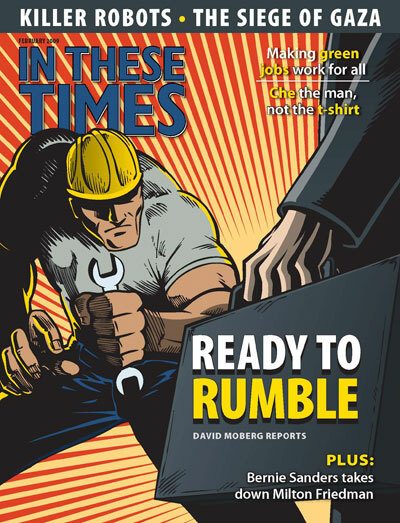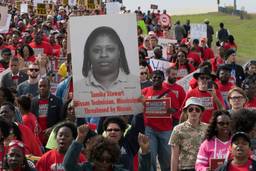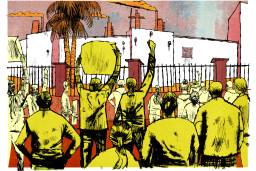Ready to Rumble
Workers and Corporate America battle over the Employee Free Choice Act.
David Moberg

As President Obama and a more solidly Democratic Congress get down to work, their first priority will be dealing with three decades of fiscal mismanagement. The destruction of government as a stabilizing force – along with financial deregulation, corporate globalization and wealth redistribution to the rich – have led to the deepest economic crisis since the Great Depression. This great 30-year shift in wealth, power and public priorities coincided with – and was in large part caused by – the decline of a labor movement under assault from corporations and right-wing ideologues.
No single remedy will fix all that ails America, nor is any strategy likely to succeed if it does not give working people more power over their jobs. A renaissance for labor could ensure that workers share in the growth of their productivity and provide the stimulus of consumer demand that the economy will need for a sustained recovery. Consequently, one of the most critical political battles this year will be the fight over the Employee Free Choice Act (EFCA). Passed by the House but filibustered in the Senate in 2007, the act would make it easier for workers to form unions.
Here’s how it would work: When a majority of workers sign union authorization cards, they would gain recognition for their union. EFCA would sharply increase penalties against employers who violate labor laws when workers organize. It would provide workers faster relief from violations, such as firing for union activity. And it would provide the option of mediation and arbitration if the employer and union fail to reach a first contract on their own.
It is a modest reform that could not only help workers who join unions but all working people, the economy and the future of progressive politics.
‘Armageddon’
After a long wait in line, Albert Higgins, a former security guard and now a union organizer, reaches the counter at a super-sized McDonald’s in downtown Chicago. “One small hot chocolate,” he says. Then, addressing the clerk, he asks, “Francisco, do you know that your boss is making more than $6,000 an hour while you’re making $8?”
Higgins and other union supporters were poking back at the fast food giant, whose president, Don Thompson, in late November, urged 2,400 franchise owners to contact Congress to oppose EFCA.
Corporate America is girded for battle. An employer offensive – costing upward of $100 million, according to union estimates – is being mobilized against EFCA. Randel Johnson, vice president of the U.S. Chamber of Commerce, described the coming battle over the act as “Armageddon.” The Chamber has pledged $10 million toward the war against EFCA.
During last year’s election campaign, Wal-Mart told its supervisors that voting for Democrats would lead to passage of EFCA, which would be bad for the corporation. And Home Depot founder Bernie Marcus raged that corporate executives who did not contribute to endangered Republican Senate candidates “should be shot.”
Shadowy front groups, with undisclosed financial backing that almost certainly comes from major corporations and rich right-wingers, have entered the fray.
Richard Berman, profiled by CBS’s “60 Minutes” as “Dr. Evil,” is a notorious anti-consumer publicist and a hired gun for the alcohol, tobacco and fast food industries. Berman, who has close ties to the Bush administration and the Chamber of Commerce, operates the Center for Union Facts (and its spin-off the Employee Freedom Action Committee) and produces hyperbolic anti-EFCA ads that depict union leaders as crooks and thugs.
Other anti-EFCA front groups include the corporate alliance called Coalition for a Democratic Workplace, Americans for Job Security (a Chamber of Commerce front group financed by the insurance industry), the old-line National Right to Work Committee (along with its offspring, the Public Service Research Foundation), and right-wing kingmaker Grover Norquist’s Alliance for Worker Freedom.
Corporations and the right argue that EFCA will take away the secret ballot, let union thugs intimidate workers into joining unions and destroy businesses. But EFCA does not eliminate the option of National Labor Relations Board (NLRB) elections, even though most unions would pursue majority sign-up when they can. EFCA simply gives the right to choose the method to workers and unions, not the employers.
And it is employers – not unions – that have intimidated workers. In 2007, nearly 30,000 workers suffered illegal employer retaliation for exercising their rights at work, roughly five times as many than in 1967, according to the NLRB.
Even a survey by the anti-union HR Policy Associates turned up only 42 clear cases of union misconduct in signing union authorization cards in the more than 70 years since the National Labor Relations Act was passed in 1935, according to the AFL-CIO.
In forming a union, workers are simply voluntarily associating – as protected under federal and international human rights laws – in order to establish a collective voice to counterbalance the power of employers. They are not voting between two candidates: management and a union.
Further, the employer defense of secret ballots is a sham. “Workers without a union don’t vote on anything,” says Tom Woodruff, director of Change to Win’s strategic organizing center. “When was the last time non-union voters voted on a pay raise?” For that matter, when did corporations seek worker secret ballots on executive pay or offshoring jobs?
EFCA opponents object to unions on principle. And, if they could, they would make it even harder for workers to unionize. What they want is power – and the wealth they can capture with that power.
“We like driving the car, and we’re not going to give the steering wheel to anybody but us,” outgoing Wal-Mart CEO Lee Scott said when asked about EFCA.
Corporations and Republicans are attacking not just EFCA’s rule changes but unionism itself – even the notion that workers should be paid well. Taking aim at the United Auto Workers in particular, they have used the Detroit Three auto crisis to argue that unions – and good wages – are bad in a global economy.
In an unsigned copy of a Dec. 10 memo circulated among Washington Republican insiders, conservative Republicans criticized auto industry aid as Democratic payoff to organized labor. They wrote, “This is a precursor to card check and other items. Republicans should stand firm and take their first shot against organized labor, instead of taking their first blow from it.”
The attack will get nastier, and labor needs to respond by going on the offensive. “We have to expose them,” Woodruff says. “They brought us the disaster we’re in. If we follow them, we’ll be stuck in this disaster, or worse. People voted for change. We have to organize and demand the change we voted for.”
Aggressive tactics
When private employers fight against unionization, they often do so with tactics that are illegal or barely legal.
Kate Bronfenbrenner, director of labor education research at Cornell University, has found in her most recent research that “employer opposition has steadily increased,” including in “intensiveness and aggressiveness,” such as firing union supporters.
Employer opposition takes its toll, as workers fear for their jobs or economic wellbeing. In the face of employer hostility and long, drawn-out campaigns for union recognition, workers grow cynical or disillusioned, persuaded that collective action is futile, even if they would like a union.
Even when unions have enough worker support – usually well over a majority – to call an election, workers only succeed in winning recognition and a contract 20 percent of the time, according to a study of union elections from 1999 to 2004 conducted by John-Paul Ferguson and Thomas A. Kochan, respectively a graduate student and professor of management at the Massachusetts Institute of Technology. When employers fought unions so aggressively that they were charged with an unfair labor practice, only one in 10 petitions for an election resulted in a contract.
If employers are caught violating the law now, their actions – like firing a union supporter – can be redressed only long after they have chilled workers’ desire to organize. And compared to other workplace violations, like racial or sexual discrimination, the penalties against employers are minuscule – such as posting a promise not to break the law again.
Bill Lawhorn and Lucille Musser are victims of our present weak labor laws.
In 2002, tired of watching Consolidated Biscuit Company (CBC) supervisors harass other workers, Bill Lawhorn contacted the Bakery, Confectionary, Tobacco Workers and Grain Millers union, hoping that he and fellow employees could organize a union and improve life in the McComb, Ohio, factory. Out of 875 workers, 650 agreed and signed union cards. But the company responded by bringing in a professional anti-union firm and insisted on holding an election.
Supervisors threatened that if the union won there would be pay cuts, that immigrant Latino workers would lose their jobs and that the plant might even be closed. They came to Lawhorn’s house and told him he would be fired if the union won.
The scare campaign worked. The union lost. The next day, the company fired Lawhorn.
On Dec. 3, 2008, more than six years after he was fired, the National Labor Relations Board finally restored Lawhorn’s job, following lengthy CBC appeals of the 40 complaints filed against it.
“Labor laws in this country are just bad,” says Lawhorn, 52, a forklift driver who joined in a new drive to organize a union when he returned to work. “I thought I had a protected right to do this union organizing. Apparently not. They say I won this case, but it took over six years. The owner lost, but he won: He tells everyone, ‘If you try to get a union, this will happen to you.’ “
Such employer abuse is the main reason why, even though more than half of non-union workers say they would like to join a union, the share of the work force in labor unions continues to shrink – down from around 35 percent in the mid-1950s to 12 percent today, with only 7.5 percent in the private sector.
Lawhorn, who is still fighting for a union, says, “If we’d passed the Employee Free Choice Act, we’d be working on our third contract now.”
Perhaps. Consider the case of Lucille Musser. She knows all too well, that even if workers at her job had voted for the union six years ago, they might not have a contract yet. In late 2005, Musser, 70, and several dozen other workers at Heartland Human Services, a private nonprofit mental health facility in the small southern Illinois town of Effingham, decided they needed a union to protect them from a capricious boss.
They quickly approved the American Federation of State, County and Municipal Employees (AFSCME) as their union, but contract negotiations dragged on fruitlessly – even with mediation and a union offer of arbitration. The workers went on strike in July 2007, but Heartland brought in strikebreakers. Nearly a year later, the strikers collectively walked back in to rightfully reclaim their jobs, but Heartland locked them out.
“I knew it would be difficult but worth it,” Musser says. “We knew Heartland would not change if we didn’t do something drastic. But had the Employee Free Choice Act been in effect, we would not have had to go out on strike.” And they would have had a contract by now.
Original intent
Organizing was quite different after the Wagner Act, also known as the National Labor Relations Act, passed in 1935. The NLRB recognized unions either through majority sign-up (about one-fourth of cases) or elections (often used to determine worker support when there were competing unions, company-sponsored unions, or unions organized “top-down” with employer agreement).
For the drafters of the act, “it was inconceivable that, given the opportunity, workers would not join a union,” says James Gross, Cornell University professor of labor policy. Typically 80 percent to 90 percent of workers voted for a union.
“The NLRB ruled early that the selection of the bargaining representative was none of the employer’s business, either for or against. It was solely the business of the employees. Any statement from employers was inherently coercive,” says Gross.
Indeed, the law’s principal author, Sen. Robert Wagner (D-N.Y.), considered the purpose of the law to encourage collective bargaining as a counterweight of “industrial democracy” to the “economic despotism” of wage labor. Since then, however, through both court and administrative actions, the balance of rights and power has shifted to employers.
Is EFCA enough?
Labor strategists have long debated over how best to remedy the situation. Should labor once again try to restrict employers’ speech, forcing them to be neutral, so only workers decide if they want a union? Should labor try to equalize access to the workplace for both union organizers and employers? Should labor try to require that all work places be represented by a union and collective bargaining, but give workers the choice of what kind of representation they want? Or, as John Wilhelm of UNITE HERE!, the hotel and garment workers’ union, argues, should labor focus less on legislation and more on convincing President Obama to support organizing campaigns?
EFCA came out of a 2003 summit meeting of 245 union organizers from 45 unions. Unions then began introducing workers who had gone through organizing drives to politicians and made EFCA central to their political endorsements.
“Having workers feel that they truly do have a right to form unions, that employers will be punished for violating their rights, and that there is a smooth, streamlined process available to them will solve the majority of problems,” says AFL-CIO organizing director Stewart Acuff.
In elections last year, especially in hotly contested Senate races in North Carolina and Minnesota, a group of unions informally worked together to counter efforts by far-right political action groups and corporations to attack Democratic candidates’ support for EFCA.
Labor is keeping its political apparatus intact to mobilize support from both union members and the citizens. To that end, public education will be critical: Many people – even union members – do not understand what workers face when organizing, nor do they understand how a stronger labor movement benefits even non-members. In December, a Peter Hart poll found that 73 percent of the public – including 37 percent who felt strongly – favored the Employee Free Choice Act after hearing its three provisions. This poll hints at what education could mean for public support of EFCA.
Getting through the Senate
Early this year, unions plan to present 1 million signatures in support of EFCA to Congress, and they are calling on allies from civil rights, environment, religious and other movements to broaden the campaign beyond labor. American Rights at Work, a labor-founded coalition, is playing a leading role in this effort.
EFCA almost certainly has majority support in the House and Senate, but it is less clear that Democrats can muster the 60 votes needed in the Senate to stop a filibuster. Already, Sen. Blanche Lincoln (D-Ark.), with virulently anti-union Wal-Mart and Tyson as corporate constituents, has signaled she’s not sure EFCA is needed. And another four to six Democratic senators from relatively rural or non-union states are also uncertain (though some Democrats and moderate Republicans might be persuaded to vote for cloture, if not the bill itself). Yet even if a cloture vote fails, Democratic leaders have parliamentary options to move the legislation.
Obama continues to publicly support EFCA, but the question remains as to how much influence he is willing to expend both publicly and privately for the bill when he is pushing so many other initiatives. Unions insist that EFCA must be an integral part of both the economic stimulus and Obama’s promised plan to restore the middle class.
Tom Woodruff puts it this way: “The Employee Free Choice Act is essential to the economic recovery of the country, doing something about the income inequality that fed the recession – near depression – we’re in today.”

I hope you found this article important. Before you leave, I want to ask you to consider supporting our work with a donation. In These Times needs readers like you to help sustain our mission. We don’t depend on—or want—corporate advertising or deep-pocketed billionaires to fund our journalism. We’re supported by you, the reader, so we can focus on covering the issues that matter most to the progressive movement without fear or compromise.
Our work isn’t hidden behind a paywall because of people like you who support our journalism. We want to keep it that way. If you value the work we do and the movements we cover, please consider donating to In These Times.
David Moberg, a former senior editor of In These Times, was on staff with the magazine from when it began publishing in 1976 until his passing in July 2022. Before joining In These Times, he completed his work for a Ph.D. in anthropology at the University of Chicago and worked for Newsweek. He received fellowships from the John D. and Catherine T. MacArthur Foundation and the Nation Institute for research on the new global economy.







